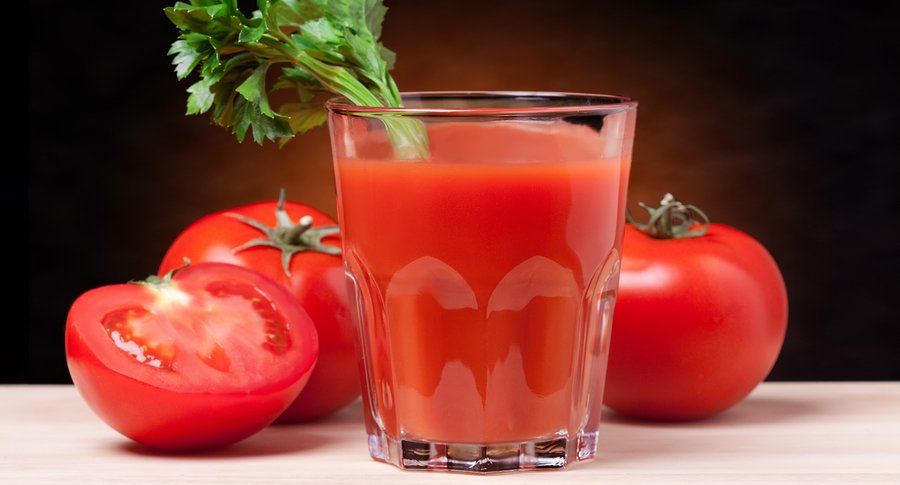Article Summary:
- A daily cup of tomato juice may lower the risk of heart disease
- Tomato juice is a great source of antioxidants like lycopene
- Maximize your benefits by making fresh tomato juice
Health Benefits of Tomato Juice
You are undoubtedly well aware that tomatoes are a healthy food, rich in vitamins, fiber, potassium, and antioxidants such as lycopene to benefit your body. But your consumption of tomatoes likely focuses on eating the fruit sliced on sandwiches, chopped in salads, or pureed in sauces. When you think about tomato juice, it may be more of an afterthought, such as a mix for a Bloody Mary. But new research suggests that tomato juice might be worth incorporating into your diet regularly to boost your heart health.
Research on Health Benefits of Tomato Juice
The study, which was conducted at Tokyo Medical and Dental University in Japan, found that consuming a cup of tomato juice every day is associated with a lower risk of developing heart disease.1Odai, Tamami; et al. “Unsalted tomato juice intake improves blood pressure and serum low-density lipoprotein cholesterol level in local Japanese residents at risk of cardiovascular disease.” Food Science & Nutrition. 15 May 2019. Accessed 26 June 2019. http://onlinelibrary.wiley.com/doi/full/10.1002/fsn3.1066. These results are based on an investigation that included 481 Japanese men and women, who were provided with as much unsalted tomato juice as they desired over the course of a year.
The subjects had physical exams that measured several risk factors for cardiovascular disease at the beginning of the research period and again at the end. In the interim, the participants maintained diaries of their daily tomato juice consumption and also recorded any health changes they experienced. By the end of the year, blood pressure rates decreased by an average of three percent in the volunteers who had untreated pre-hypertension or hypertension. And those with high cholesterol had an average 3.3 percent drop in their rates of LDL or “bad” cholesterol.
Tomato Juice is a Top Source of Lycopene
While both tomatoes and tomato juice contain antioxidants such as lycopene, this carotenoid is considerably more abundant and bioavailable in tomato juice than it is in the fruit as a whole. That’s because the heating process concentrates the lycopene and alters it in a way that makes it more easily absorbed by the body. One cup of tomato juice contains approximately 23 milligrams of lycopene.
Lycopene protects the body’s cells from the damage done by free radicals. This helps reduce the chronic inflammation that is linked to so many conditions, including heart disease. And the current investigation is not the first time lycopene has been shown to benefit the heart, as a 2013 study at Tehran University of Medical Sciences in Iran found that drinking tomato juice decreased inflammation and reduced the risk of both cardiovascular disease and diabetes.2Ghavipour, M.; et al. “Tomato juice consumption reduces systemic inflammation in overweight and obese females.” British Journal of Nutrition. June 2013. Accessed 27 June 2019. http://www.ncbi.nlm.nih.gov/pubmed/23069270. What’s more, tomato juice is also rich in vitamin C and beta-carotene, both of which are associated with eye health and other benefits.
The Healthiest Version of Tomato Juice
Many people shy away from store-bought juices and for good reason, since they often contain added salt and sugar to increase their flavor, which makes them considerably less healthy. In the case of tomato juice, there is typically an extraordinarily high sodium content that will quickly counteract any benefits the juice itself provides to the heart. So, if you’re buying tomato juice at the market, be sure to read labels carefully. Choose only a product that is 100 percent tomato juice with no added salt or sugar.
But an even better way to go is to make your own tomato juice at home. For the simplest version, wash three large tomatoes, remove the cores, and cut them into quarters. Place the tomatoes in a saucepan and simmer for about 30 minutes until they become tender. Afterward, blend them until they’re smooth, pour out two cups worth, and drink or freeze them. (Note: you can dilute with water to get any consistency you desire.) If a broader vegetable flavor is more to your liking, you can always add one to two stalks of celery, one to two carrots, one-quarter of an onion, some fresh basil leaves, and/or a dash of sea salt and pepper to create your own perfect recipe.
References
| ↑1 | Odai, Tamami; et al. “Unsalted tomato juice intake improves blood pressure and serum low-density lipoprotein cholesterol level in local Japanese residents at risk of cardiovascular disease.” Food Science & Nutrition. 15 May 2019. Accessed 26 June 2019. http://onlinelibrary.wiley.com/doi/full/10.1002/fsn3.1066. |
|---|---|
| ↑2 | Ghavipour, M.; et al. “Tomato juice consumption reduces systemic inflammation in overweight and obese females.” British Journal of Nutrition. June 2013. Accessed 27 June 2019. http://www.ncbi.nlm.nih.gov/pubmed/23069270. |












Why the need to simmer tomatoes before blending in order to make tomato juice? Would blending not produce enough warmth to alter the lycopene and increase its absorption?
You would have to check with your blender manufacturer; most do not bring the juice to a simmer.
Hey, very nice blog. I came across this on Google, and I am stoked that I did. I will definitely be coming back here more often. Wish I could add to the conversation and bring a bit more to the table, but am just taking in as much info as I can at the moment. Thanks for sharing.